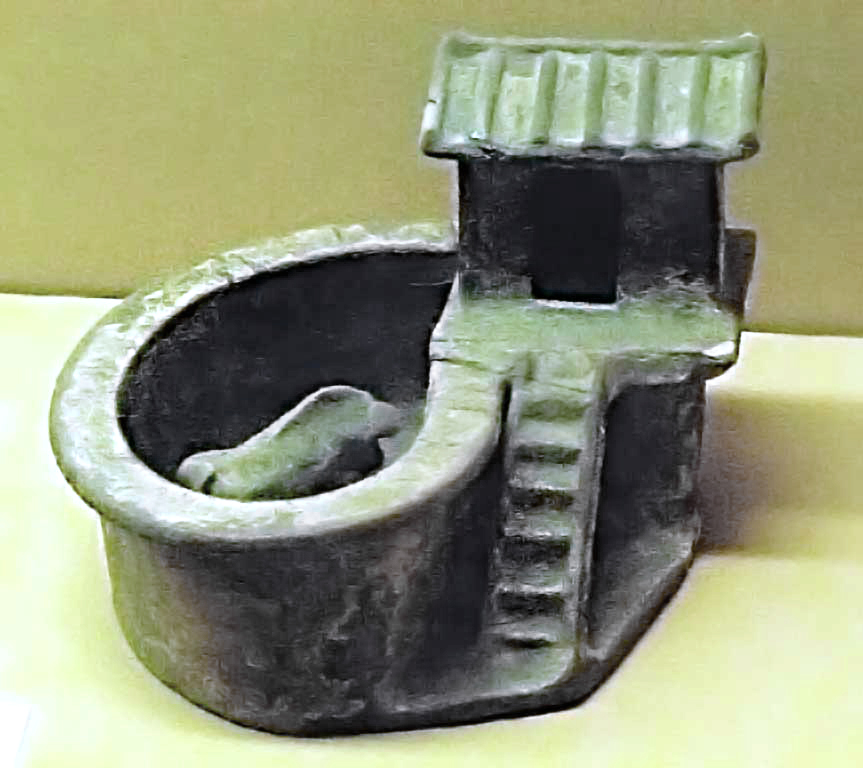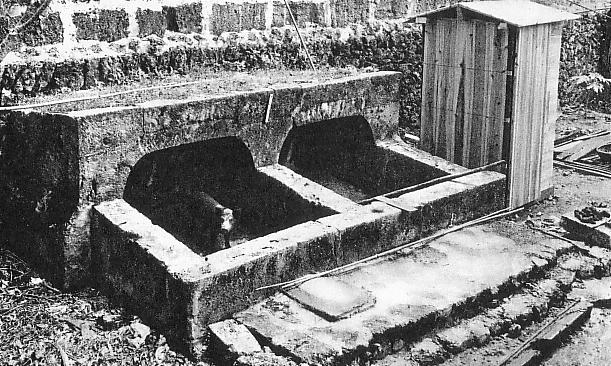Pig toilet on:
[Wikipedia]
[Google]
[Amazon]
 A pig toilet (sometimes called a "pig sty
A pig toilet (sometimes called a "pig sty
 Chinese influence may have spread the use of pig toilets to
Chinese influence may have spread the use of pig toilets to
 A pig toilet (sometimes called a "pig sty
A pig toilet (sometimes called a "pig sty latrine
A latrine is a toilet or an even simpler facility that is used as a toilet within a sanitation system. For example, it can be a communal trench in the earth in a camp to be used as emergency sanitation, a hole in the ground ( pit latrine), or ...
") is a simple type of dry toilet consisting of an outhouse
An outhouse is a small structure, separate from a main building, which covers a toilet. This is typically either a pit latrine or a bucket toilet, but other forms of dry (non-flushing) toilets may be encountered. The term may also be used ...
mounted over a pigsty
A sty or pigsty is a small-scale outdoor enclosure for raising domestic pigs as livestock. It is sometimes referred to as a hog pen, hog parlor, pigpen, pig parlor, or pig-cote, although pig pen may refer to pens confining pigs that are kep ...
, with a chute or hole connecting the two. The pigs
The pig (''Sus domesticus''), often called swine, hog, or domestic pig when distinguishing from other members of the genus '' Sus'', is an omnivorous, domesticated, even-toed, hoofed mammal. It is variously considered a subspecies of ''Sus ...
consume the feces of the users of the toilet, as well as other food.
History
Pig toilets ( ''zhūquānmáokēng'') were once common in rural China, where a single Chineseideogram
An ideogram or ideograph (from Greek "idea" and "to write") is a graphic symbol that represents an idea or concept, independent of any particular language, and specific words or phrases. Some ideograms are comprehensible only by famili ...
() signifies both "pigsty" and "privy". Funerary models of pig toilets from the Han dynasty
The Han dynasty (, ; ) was an imperial dynasty of China (202 BC – 9 AD, 25–220 AD), established by Liu Bang (Emperor Gao) and ruled by the House of Liu. The dynasty was preceded by the short-lived Qin dynasty (221–207 BC) and a warr ...
(206 BC to AD 220) prove that it was an ancient custom. These arrangements have been strongly discouraged by the Chinese authorities in recent years, although as late as 2005 they could still be found in remote northern provinces.
Okinawa
is a prefecture of Japan. Okinawa Prefecture is the southernmost and westernmost prefecture of Japan, has a population of 1,457,162 (as of 2 February 2020) and a geographic area of 2,281 km2 (880 sq mi).
Naha is the capital and largest city ...
(Okinawan: ふーる (''fūru'') / 風呂) before World War II
World War II or the Second World War, often abbreviated as WWII or WW2, was a world war that lasted from 1939 to 1945. It involved the vast majority of the world's countries—including all of the great powers—forming two opposing ...
, and also to the Manchu people during the Qing Dynasty
The Qing dynasty ( ), officially the Great Qing,, was a Manchu-led imperial dynasty of China and the last orthodox dynasty in Chinese history. It emerged from the Later Jin dynasty founded by the Jianzhou Jurchens, a Tungusic-spea ...
period.
Pig toilets were also used in parts of India such as Goa. A 2003 survey of sanitary arrangements in Goa and Kerala
Kerala ( ; ) is a state on the Malabar Coast of India. It was formed on 1 November 1956, following the passage of the States Reorganisation Act, by combining Malayalam-speaking regions of the erstwhile regions of Cochin, Malabar, South ...
found that 22.7% of the population still used pig toilets.
On Jejudo, a volcanic island of South Korea that is home to a breed of black pig, the pig toilets were known as ''dottongsi'' (). These pigsty toilets were still in use in the 1960s.
Fishpond toilet
In China, "Family dwellings are commonly built close to the fish pond with toilets overhanging the pond to facilitate fertilization. ... Some pigsties as well as latrines for humans are built on the adjacent dike so as to overhang the pond." But by 1988, these fish pond toilets were falling out of favour, as the farmers found it more useful to ferment human and pig excrement together, and apply it to the aquaculture ponds as needed. In Vietnam, the traditional fish pond toilet, which was described as "widespread" as recently as 2008, polluted the waterways, but was perceived as more hygienic (less smelly) than various modern alternatives that the government was pressing on the villagers.See also
* Coprophagia *History of water supply and sanitation
The history of water supply and sanitation is one of a logistical challenge to provide clean water and sanitation systems since the dawn of civilization. Where water resources, infrastructure or sanitation systems were insufficient, diseases spr ...
*Toilet god
A toilet god is a deity associated with latrines and toilets. Belief in toilet gods – a type of household deity – has been known from both modern and ancient cultures, ranging from Japan to ancient Rome. Such deities have been associated with h ...
References
{{Pigs Animals and humans Pigs Toilets Fish and humans Mammals and humans